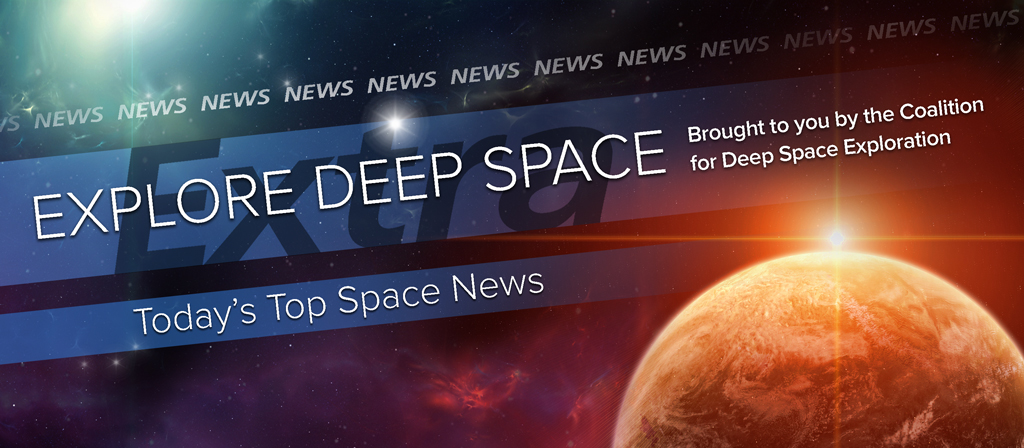In Today’s Deep Space Extra… NASA readies the next Orion crew capsule for a key 2018 deep space test, while exploration advocates raise concerns over proposed budgets for the spacecraft and its Space Launch System heavy lift rocket.
Human Deep Space Exploration
NASA prepares Orion spacecraft for its first big mission
ABC News (2/11): The NASA/Lockheed Martin weight reduced Orion crew exploration capsule assigned to Exploration Mission-1 is now at NASA’s Kennedy Space Center where it will undergo testing and final assembly. The first uncrewed test launch of Orion paired with the Space Launch System exploration rocket is planned for late 2018. The three week test flight will send the heavily instrumented capsule around the moon and back to Earth,
President Obama proposes $19bn budget for NASA in 2017
Aerospace Technology.com (2/12): Human exploration advocates raise concerns over reductions in development activities for the Space Launch System exploration rocket and Orion crew capsule included in the proposed 2017 budget President Obama presented Congress this week.
Apollo 11 astronauts wrote on moon ship’s walls, Smithsonian 3-D scan reveals
Collectspace.com (2/11): New 3-D scans of the Apollo 11 command module Columbia reveal scribbles on the inside walls written by astronauts Neil Armstrong, Buzz Aldrin and Michael Collins. The finding came as the module, which is on public display, was moved from one place to another within the National Air and Space Museum in Washington D.C.
Infinity and beyond: NASA lures space travelers with ‘Visions of the Future’
CNN (2/12): Artists from NASA’s Jet Propulsion Laboratory have created a line of imaginative space travel posters illustrating the diversity among the planets of the solar system. “Europa: Discover life under the ice,” reads one touting the cold, ocean covered Jovian moon.
The Soviet Union’s secret moon base that never was
Popular Mechanics (2/11): New information reveals the former Soviet Union planned a moon base as it faced a race to the moon with the United States.
Space Science
Gravitational waves found emanating from merging black holes
Astronomy Now (2/11): Scientists have confirmed the presence of gravitational waves, or ripples in space time, originating from the merger of two black holes 1.3 billion light years away. The observation announced Thursday in Washington D.C. and made using the Laser Interferometer Gravitational-wave Observatory confirms predictions from Albert Einstein’s General Theory of Relativity.
Gravitational waves explained
Science News (2/11): The waves, as Albert Einstein predicted, are ripples in space time. A pair of complex terrestrial observatories joined forces to detect the ripples generated by the merger of distant black holes.
Scientists bid comet lander Philae farewell after radio silence
Reuters (2/12): The European and German space agencies are ending efforts to establish contact with the Philae lander, which tumbled to a landing on the comet 67P/Churyumov-Gerasimenko in November 2014 as part of the Rosetta mission. The touchdown appears to have left the lander in a shaded area where its solar power system could not re-charge.
Year of DSCOVR-y: Joint NASA/NOAA Earth-watcher celebrates 12 months of operations
AmericaSpace.com (2/11): After a long wait to lift off, the joint NASA, NOAA and U.S. Air Force DDCOVR mission has marked a year in space providing observations of the sun for space weather forecasts and providing imagery of the sunlit disc of the Earth.
Extraterrestrial life could be vulnerable to greenhouse effect
Space.com (2/11): Despite estimates of vast numbers of Earth like planets circling other stars in the Milky Way, the emergence of intelligent life could be stifled by rising surface temperatures and moisture loss due to rising concentrations of CO2 in their atmospheres, according to computer simulations.
Low Earth Orbit
Dextre demo paving the way for robotic EVA assistance
NASAspaceflight.com (2/11): A Canadian built extension of the International Space Station’s Remote Manipulator System, or robot arm, has achieved a milestone, demonstrating that it could take on a task once assigned to NASA space walkers, the change out of an external Main Buss Switching Unit.
Launch of Japanese X-ray observatory postponed
Spaceflightnow.com (2/11): Bad weather prompted a delay in plans Friday to launch Japan’s Astro-H astrophysics observatory. NASA, Europe and Canada are mission contributors.

